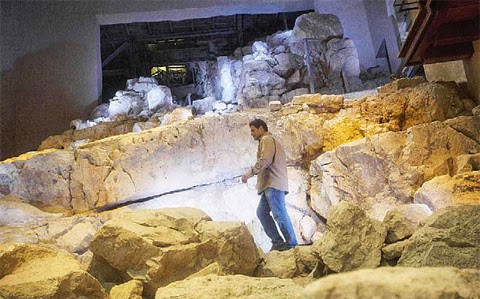Recent reports have been coming out of Jerusalem concerning the discovery of King David’s Citadel. The Citadel is recorded in the book of 2 Samuel 5:6-9 as the entry point for the forces under David’s command when he attacked the city of Jerusalem. Eli Shukron, an archaeologist formerly with the Israel Antiquities Authority (IAA), believes the archaeological excavations in question are the location mentioned in the Bible. As it seems with any claims associated with King David, Shukron’s theories have been met with considerable skepticism.
The king and his men marched to Jerusalem to attack the Jebusites, who lived there. The Jebusites said to David, “You will not get in here; even the blind and the lame can ward you off.” They thought, “David cannot get in here.”7 Nevertheless, David captured the fortress of Zion—which is the City of David.
8On that day David had said, “Anyone who conquers the Jebusites will have to use the water shaft to reach those ‘lame and blind’ who are David’s enemies.” That is why they say, “The ‘blind and lame’ will not enter the palace.”
9David then took up residence in the fortress and called it the City of David. He built up the area around it, from the terraces inward.
2 Samuel 5:6-9

The excavations have uncovered a set of parallel walls as well as a tower next to a pool and a second massive tower which was positioned to protect the Gihon Spring. Some of these walls were constructed using 5 ton stones stacked as much as 21 feet across. These excavations, overseen by Shukron and his partner Ronny Reich, are not new. In fact the excavations at this site began almost 15 years ago and were concluded 2 years ago. So the site is well known and the dates for the walls and towers do not seem to be in question. Most scholars agree the fortifications were built in the late 18th century B.C.
While the date of construction for the walls and towers is almost universally accepted, there is some debate caused by the lack of pottery shards from the 10th century B.C. Pottery is widely used to help date an archaeological site and is generally very accurate. In this case Shukron and Reich found very little 10th century pottery in their excavations, which is a point of concern for some. Reich believes the lack of pottery shards from the 10th century B.C. raises some doubts as to if the fortifications were in use at that time. While it would be nice to have this type of confirmation, when simple logic is applied it seems completely unnecessary. If the construction date of 1804 is accepted as factual, and the structures still exist today, then it stands to reason they were there in the 10th. As Shukron points out the 10th century pottery shards would probably have been removed by the occupants since he believes the fortifications were in continuous use from the time of their construction until well after King David entered the city. A large number of pottery shards were discovered from approximately 100 years after the time of King David. This seems to match Shukron’s theory very well. Confidence in this time-line is not shared by all archaeologists and is the primary area of controversy regarding Shukron’s theories. This however, is not the only are of contention.
Other archaeologists believe the citadel was in use in the 10th century B.C. but are not totally convinced it is the same fortifications mentioned in the Bible. While Shukron claims the site matches the Bible’s description perfectly and is the only possible match in the City of David, others are hesitant. The fortifications did guard the city’s water supply and there was a tunnel discovered through which excess water would have flowed out of the city. It is believed it was this tunnel which David’s men used to gain access to the heavily fortified city. On the surface the area and time-line seem to match the Biblical narrative, and while archaeologist such as Reich are willing to agree this is a significant discovery, they are not ready to associate it with the Biblical narrative.
There seems to always be controversy when archaeologists attempt to use the Bible as a reference or research tool in their work. In this case however, there are other political issues which some say is improperly influencing the claims regarding the fortifications. The foundation which funded the excavations also purchases the homes of Arabs around excavation sites and then helps Jewish people move into these homes. Some see this as a political agenda by the group which is made up of mostly Jews from the United States and Great Britain. This political association with the excavation tarnishes the claims for some as questions of motives and undue influence are raised. Regardless of these claims, the excavations have resulted in a sizable discovery of some importance, even if its relationship to the Bible remains uncertain for some.



